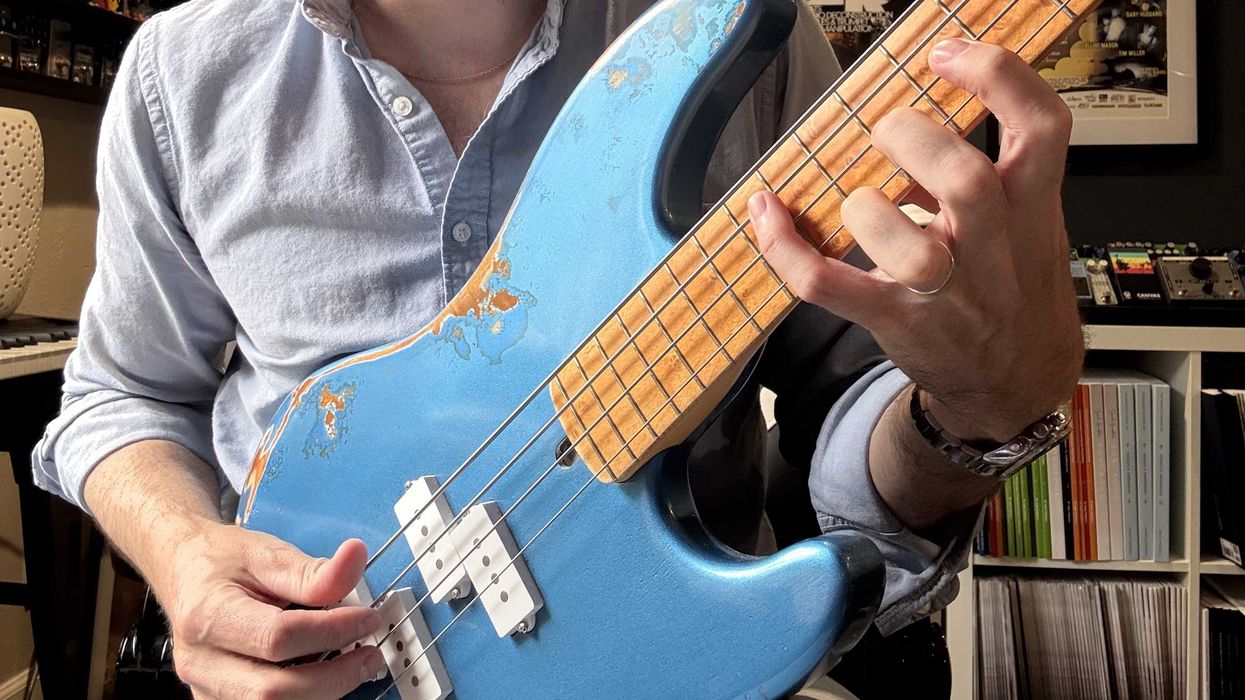At the 2010 Orlando Guitar Show, a reader
named Thom asked me this question: What
is a better bass, a 1960s Precision or a 1960s
Jazz bass? To me that is akin to asking,
“Who would you rather date, Marisa Tomei
or Julia Roberts?” I told Thom either is a
great choice, and the next thing I knew, I was
having a roundtable discussion on the differences
between the two basses.
To understand the differences, we need to
consider the following:
1. What are the differences within
each model?
2. What are the similarities between the
two models?
3. What are the differences between the
two models?
4. What are the objectives of use for
each model?
This information is based upon my 35+ years
of experience with these instruments. Your
individual style may yield a different result.
This discussion will center around 1960
through 1967 model years, though we won’t
be discussing all the minor nuances.
Differences Within the Models
Like automobile makers of the era, Fender
always seemed to make slight changes, and the
occasional large change, between the model
years. In my opinion, the tone of a great bass
begins at the neck, with many little nuances
adding up to a major change in tone. The
Precision bass, in particular, always seemed to
have tweaks made to the neck dimensions.
From 1960 to the middle of 1962, you had the
slightly rounded, mid-sized neck profile. From
later 1962 to mid 1963, the neck seemed to
gain some girth. In later 1963 through mid
1964, you had the “wide and flat” profile, which
is my personal favorite. The standard round C
neck followed in 1965, and remained through
the early ’70s. The Jazz bass experienced some
structural changes through these years, but the
neck dimensions remained somewhat static until
the block marker introduction in 1966.
With all Fender models, the early ’60s
brought the “slab board” fretboard, as
opposed to the “veneer board,” which was
introduced in mid 1962. The slab board was a
thick piece of rosewood that joined the neck
on a flat plane; the veneer board was thinner
and joined the neck on a curved plane. Clay
fretboard dots were standard until the middle
of 1964, when pearl dots arrived. Fret wire
also grew in size through the years.
One of the other sizable changes, in my
opinion, came with the switch from black to
gray bobbin pickups. The black bobbin pickups
seemed to have a warmer “Jamerson”
type of tone, where the gray bobbins
seemed more middy and focused. Some of
the best pickups ever made were the hot
and middy 1966 pickups. The combination
of pickups and neck profiles seem to really
define the personality of each individual
bass, whether it is a P or a J.
Lastly, the one other big change for both
models was the switch away from a nitro-based
finished to a poly-based finish. This
started as early as 1966, and again, in my
opinion, makes a huge difference in tone.
Differences Between the Models
The biggest differences between Precision and
Jazz basses are the neck profile and the pickup
configuration. No one will ever mistake one
neck for the other. The Jazz bass neck measures
roughly 1 9/16" at the nut. The profile is slim
and gradually tapers outward as you go down
the neck. This neck is fast and comfortable without
being Vox-like skinny. The Precision neck is
roughly 1 3/4" at the nut and has a somewhat
fast neck, but in a different way—think of a
Porsche 911 versus a Chevelle SS.
When it comes to the pickup configuration,
the Precision takes the ease-of-use trophy.
It has two bobbins working together as one
pickup, and features Master Volume and
Tone controls. The Jazz bass has two pickups,
two Volumes, and a Tone control. By
changing the volume of one pickup on a Jazz
bass, you will dramatically change the tone
of the bass. Lastly, on an aesthetic point, the
Jazz bass body has an “offset waist,” and
quite frankly, may be the best-looking electric
bass ever made.
Similarities Between the Models
Both the P and J basses share a lot of construction
similarities and mutual hardware.
The tuners, neck plate, bridge, and pots are
the same across models. The body wood is
usually ash or alder, although I have on rare
occasions seen mahogany or other mystery
woods. The neck is maple with a glued-on
rosewood fretboard, and the neck is joined
to the body with four screws and a neck plate
embossed with the serial number.
The Objectives of Use
The bottom line is that these are both “Swiss
Army” basses—either bass can get down low
or be played funky. If you are looking for a
’60s Fender bass, there is no wrong answer.
For me, I’m a rockin’ pocket player, and 99
percent of the time I’m using a Precision
bass. I love the low end and ballsy tone
that only a good old beat up P bass can
give. Ben, my business partner, is a dyed-in-
the-wool Jazz bass player. He goes out
of the pocket and does a lot of funk and
groove work. In reality, the biggest difference
between the two basses is the neck
profile. Some folks just can’t get around on a
Precision, while others find the Jazz neck too
skinny, and that’s usually the decision maker.
Both of these basses can offer you a lifetime
of enjoyment. In my opinion, for great
straight tone and ease of use, nothing beats
a ’60s Precision. For a little bit more pizzazz
and tonal versatility (with a touch less low
end), go for the Jazz. When faced with a ’63
Precision and a ’63 Jazz in Olympic White,
I’m robbing a bank to buy them both.
Kevin Borden
Kevin Borden has been a bass player since 1975 and is currently the principle and co-owner, with “Dr.” Ben Sopranzetti, of Kebo’s Bass Works: kebosbassworks.com. He can be reached at: Kebobass@yahoo.com. Feel free to call him KeBo.




![Rig Rundown: AFI [2025]](https://www.premierguitar.com/media-library/youtube.jpg?id=62064741&width=1245&height=700&quality=70&coordinates=0%2C0%2C0%2C0)












 Shop Scott's Rig
Shop Scott's Rig















































